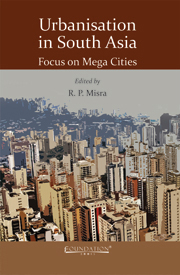Book contents
- Frontmatter
- Contents
- List of Figures
- List of Tables
- List of Contributors
- Introdution
- 1 South Asia: Land, People, and Economy
- 2 Historical Roots of South Asian Urbanisation
- 3 Mumbai: The Financial Capital of India
- 4 Delhi: Growing Problems of a Growing Megalopolis
- 5 Calcutta: The Emergence of Colonial Settlement into Megacity of the East
- 6 Chennai: A Rural Metropolis in Search of Modernity
- 7 Hyderabad: From the Feudal City to a Hi-Tech Metropolis
- 8 Bangalore: From Garden City to Silicon Valley of India
- 9 Karachi: The Commercial Capital of Pakistan
- 10 Lahore: The Cultural Heart of Pakistan
- 11 Kabul: A City in Perpetual Turmoil
- 12 Dhaka: A Mega City of Persistence and Change
- 13 Kathmandu: A City Where Tradition and Modernity Overwhelm Each Other
- 14 Thimphu: The City of Peace and Organic Development
- 15 Colombo: The Primate City of Sri Lanka
- 16 Male: Island Capital of an Island Nation
- 17 Beyond the Present: Vision of a New Urban Future
- Index
13 - Kathmandu: A City Where Tradition and Modernity Overwhelm Each Other
Published online by Cambridge University Press: 05 September 2013
- Frontmatter
- Contents
- List of Figures
- List of Tables
- List of Contributors
- Introdution
- 1 South Asia: Land, People, and Economy
- 2 Historical Roots of South Asian Urbanisation
- 3 Mumbai: The Financial Capital of India
- 4 Delhi: Growing Problems of a Growing Megalopolis
- 5 Calcutta: The Emergence of Colonial Settlement into Megacity of the East
- 6 Chennai: A Rural Metropolis in Search of Modernity
- 7 Hyderabad: From the Feudal City to a Hi-Tech Metropolis
- 8 Bangalore: From Garden City to Silicon Valley of India
- 9 Karachi: The Commercial Capital of Pakistan
- 10 Lahore: The Cultural Heart of Pakistan
- 11 Kabul: A City in Perpetual Turmoil
- 12 Dhaka: A Mega City of Persistence and Change
- 13 Kathmandu: A City Where Tradition and Modernity Overwhelm Each Other
- 14 Thimphu: The City of Peace and Organic Development
- 15 Colombo: The Primate City of Sri Lanka
- 16 Male: Island Capital of an Island Nation
- 17 Beyond the Present: Vision of a New Urban Future
- Index
Summary
Kathmandu Metropolitan City (KMC), the capital and main business hub of Nepal, is also the largest urban centre of the country. Located in the lap of the Lesser (southern) Himalayas at the junction of 27.72° N latitude and 85.37° E longitude, it is spread over an area of 5,000 ha in Kathmandu Valley at an average elevation of 1,350 m. The KMC has 701,962 inhabitants, that is nearly one-fifth (20 per cent) of the urban population of the country (2001 census). It has a built-up area of 3,844.56 ha, and an average population density of 175.7 per/ha.
Kathmandu, also called Kantipur by Newars, is a derivative of the term Kashtamandap (kastha = wood; and mandap = temple) i.e. a temple made of wood (the trunk of a single tree). Everything in and around Kathmandu appears to have the imprint of the Kasthamandapa. The name of the valley is Kathmandu, and the district in which it is located is also called Kathmandu. The tentacles of the KMC, however, reach out to the neighbouring districts of Bhaktapur, and Lalitpur too.
For centuries, Nepal had three rival royal cities: Kathmandu, Bhaktapur, and Patan, all located in Kathmandu Valley. With the unification of Nepal under Prithvi Narayan Shah (1769-1775), Kathmandu scored over its rivals, became the capital of the kingdom, and grew steadily both in area and population. Today, its physical infrastructure – transport, communication, power, and housing – is comparable to any South Asian metropolis.
- Type
- Chapter
- Information
- Urbanisation in South AsiaFocus on Mega Cities, pp. 373 - 397Publisher: Foundation BooksPrint publication year: 2012



